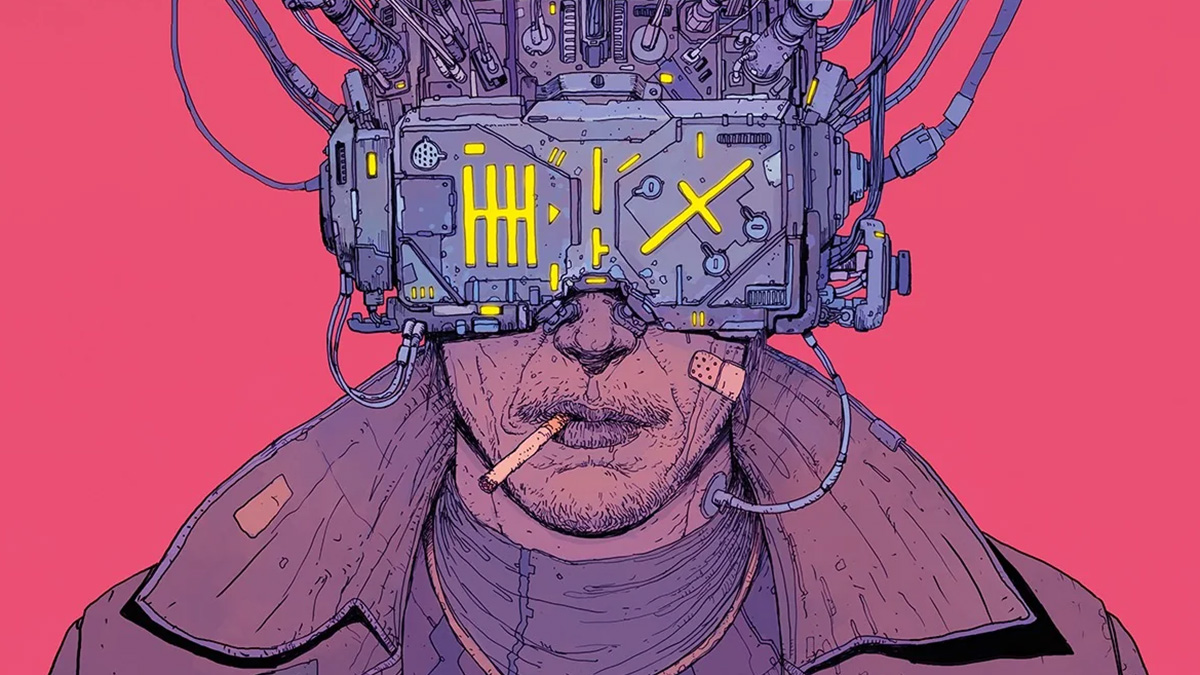To recap, the story of Neuromancer takes place in the near future, and in it, data that can be hacked in cyberspace translates to a booming criminal business. The story revolves around one former hacker, a “cowboy” named Case, who, after having his nerve-endings fried by some crooks he tried to double-cross, is pulled back into the hacking game by a shadowy organization. The epic story takes Case across a dystopian future world, including a massive city called The Sprawl, and eventually has him facing down with not one, but two different AIs. Here’s the thing though: The book was written in 1984, so Case talks about stuff like trying to sell “Three megabytes of hot RAM” while living in a high-tech world without cell phones. As Gibson jokes in his 2004 introduction to the novel, “The Sky Above the Port,” there are several moments in the book that could jar a contemporary reader, such as “Case’s puzzlingly urgent demand, when the going gets tough, for a modem.”
In Gibson’s 1984 imagination, the concept of cyberspace is more like what we saw in The Lawnmower Man, or Tron than the more mundane version of the internet we actually got. In the cyberpunk future of Neuromancer, the pull between the analog world and the digital world is more interesting, more pronounced, and extreme than the slightly lazier, and depressing way we access the internet now. There’s no need to “jack in” to cyberspace today, and nobody needs to be as cool as Case to find weird pieces of data or a meddling AI online. In Neuromancer, the menacing AI Wintermute was scary and memorable as hell. (Mission: Impossible’s “The Entity” is a near-total ripoff of Wintermute from Neuromancer.)
Today, some of us struggle with trying to turn off various glitchy AI assistants that are ruining our Word docs or Zoom calls. If I’m nostalgic for anything, it’s AI that is actually messing up my life in a cool way rather than whatever it is Gemini is doing to my search results
Update the Tech, Lose the Appeal
This is where it seems almost impossible for Neuromancer to try to update the technology of the book to match it with contemporary culture. In a sense, the romance of the book, the reason why it is so readable and such a classic is found in the 1980s cyberpunk aesthetics. Remaking the world of Neuromancer would be like remaking The Matrix, but this time, Neo isn’t allowed to wear shades, and instead, has to be dressed like Mark Zuckerberg. The basic coolness of Neuromancer is inextricably tied up in the texture of the book’s imagery, whether those exist in the virtual world, or the real world.
Sure, there are certain things a contemporary “update” of Neuromancer could pull off without having to build the narrative on a future history in which cell phones don’t exist. The nature of Night City, The Sprawl, and the “coffins” that Case sleeps in can all work in an updated future as well as an anachronistic one. Molly’s retractable razor claws can work just fine whether she has a TikTok account or not, but there’s something about imagining these characters with contemporary references that just feels off.
It would be easy to handwave this away and use something like Westworld as an example of how to walk this line effectively. Once that series left the robot amusement parks in season three, the future world it presented felt similar to ours, with some minor differences. The key to Westworld’s aesthetic success was a minimalist approach. But, shows like Westworld, and Altered Carbon, inherently dealt with analog things in a cyberpunk context: Robot bodies, clone bodies, and the like. Neuromancer is somewhat the opposite, while the analog real world (complete with payphones and “jacking in”) is a big part of the book, the virtual world is equally important to the story.

















